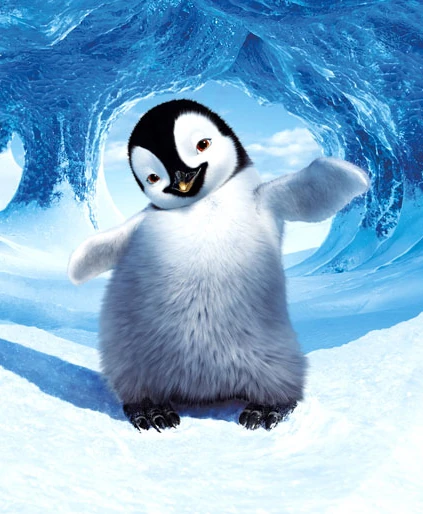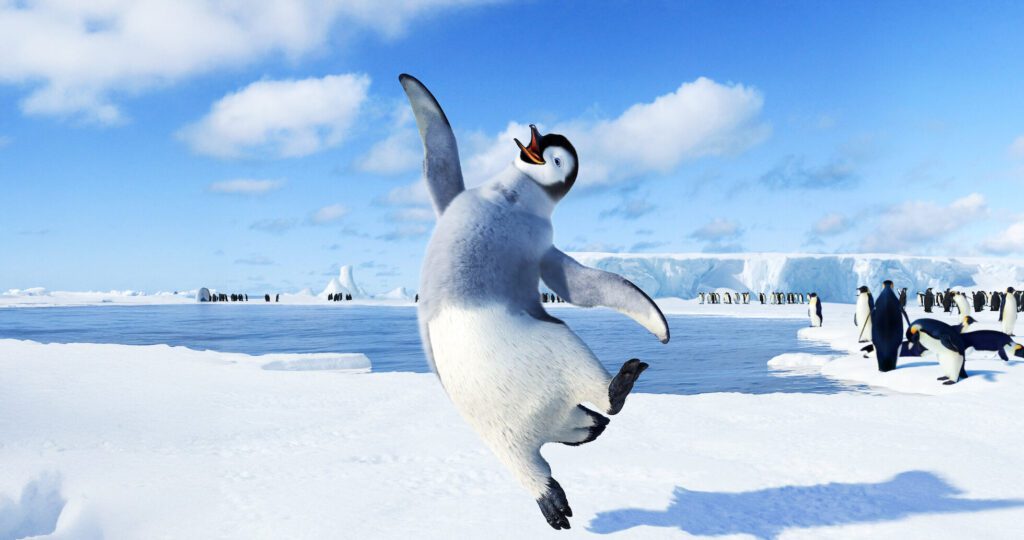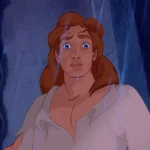Chapter 1: The Beginning of It All
Hey, everyone! Today we’re going to talk about the differences between the original script of Happy Feet and the version that hit theaters. Although the final version is excellent and much loved by the audience, it’s said that the original script had a much darker tone. Let’s explore these differences and find out what changed!
For those who don’t know, Happy Feet is an animated movie about penguins that sing – except for the main character, Mano. He was born with a unique talent: tap dancing instead of singing. And yes, that is actually his name! In the original English version, his name is Mumble, but in the translation, it became Mano. Strange? Maybe, but let’s move on.
The movie was written and directed by none other than George Miller, the genius behind Mad Max. It’s fascinating to think about how he managed to create two such different works, yet both so impactful. The idea for Happy Feet came about because Miller has always loved penguins and wanted to challenge himself by directing an animated film featuring these animals.
Chapter 2: Metaphors and Deep Messages
From the very beginning, Happy Feet stood out for addressing deep themes in an accessible way. One of the most curious aspects of the film is how the animals perceive humans. Instead of recognizing them as “humans,” they refer to them as “aliens.” This metaphor is powerful and reflects how the unknown can be interpreted in distorted ways.
Moreover, the film tackles issues of acceptance and prejudice. The protagonist, Mano, faces rejection for being different, being excluded and ridiculed by the other penguins. Here, the film opens the door to various interpretations: Mano can be seen as a neurodivergent person, a homosexual in a homophobic society, or even someone from a minority religion facing discrimination.
Anyone who has ever experienced bullying or discrimination for being different can relate to the story. And this is one of the greatest strengths of Happy Feet.
Chapter 3: Mano’s Journey
Rejected by his colony, Mano begins to question whether there is a place where he would be accepted. This thought is reinforced when, still young, he encounters a seagull who believes she was abducted by aliens. In reality, she only had an identification tag placed by humans, but this sparks Mano’s interest in other worlds and possibilities.
His first experience of genuine acceptance occurs when he meets a group of penguins from another species, led by the charismatic Ramón. These penguins are more open and welcoming, providing comedic relief and moments of warmth.
Chapter 4: A Darker Script
In the original script of the Happy Feet, the story was even more intense and aimed at an adult audience. The segregation among the penguins was more explicit, with profanity and even blood in tense scenes, such as the orca chase. This scene, which is already frightening in the final version, would have been even more impactful.
Another significant change was in the role of the older penguins, such as Noé, the spiritual leader of the colony. In the final film, they blame Mano for the fish shortage, believing his dancing is an omen that displeases the “gods.” In the original script, this theme was even more central. Mano’s dance was seen as heresy, and the prejudice against him reached extreme levels, culminating in his expulsion from the colony by his own father.
This scene, which remains in the film, is one of the heaviest and most emotional. However, in the original version, the elder penguins even encouraged a hunt for Mano, making the tone of the story much darker.
Chapter 5: The Great Guim and Religious Fanaticism
One of the most striking themes in Happy Feet is religious fanaticism, evidenced in the relationship the penguins have with the “Great Guim,” a divine figure they believe is responsible for the fish shortage. Noé, the spiritual leader of the colony, attributes the problem to Mano’s dancing, saying it’s a bad omen that displeases the deities.
There is an interesting inversion of the biblical story of Noé here. While in the Bible, Noé receives a warning from God and tries to save people from the flood, in the film, Noé is a religious leader who ignores the facts presented by Mano and uses fanaticism to blame someone different. This construction offers a critique of the dogmatic behavior of religious leaders in times of crisis, who often find scapegoats to justify real problems.
Right at the beginning of the film, we are also introduced to a peculiar superstition: they say that if a father drops his chick’s egg, the child will be born “different.” This belief torments Mano’s father, who frequently blames himself for dropping the egg and for his son being born “out of the ordinary.” Here, George Miller may be suggesting a critique of how superstitions and unfounded beliefs can negatively influence family relationships.
Chapter 6: A Journey of Questioning and Liberation
Mano is a character who, from the very beginning, refuses to accept the explanations provided by the authorities and the beliefs of his community. He rejects dogmatism and decides to seek answers on his own. This attitude is motivated both by his exclusion and by the certainty that there is nothing wrong with him, despite everyone around him claiming otherwise.
Mano’s journey is full of social and religious critiques. As he searches for the “aliens” responsible for the fish shortage, it becomes clear that the story uses this metaphor to question how closed communities tend to ignore real problems and place blame on imaginary factors or marginalized individuals.
Chapter 7: The Loving and the Archetypal False Guru
During his journey, Mano and his group encounter the Loving, a character who represents the archetype of the false guru or coach. With a necklace around his neck, the Loving claims to have been sent by the gods and that he possesses supernatural powers. He convinces the other penguins that he can answer all of life’s “whys,” as long as they pay him with pebbles.
Here, a critique of the exploitation of faith and the gullibility of people by ill-intentioned individuals is made clear. The Loving openly lies about the origin of his necklace, which, in reality, he found while swimming. In an ironic twist, the necklace starts to choke him, symbolizing how lies and greed can “tighten the neck” of those who perpetuate them.
Even though the film tries to make itself more accessible to children, these elements bring a more mature and reflective tone, touching on issues that resonate with an adult audience as well.
Chapter 8: A Darker Version That Never Saw the Light
The original script of Happy Feet included even more shocking and darker scenes. One of them would have shown Mano, still a child, getting lost in a cave and being chased by hungry penguins, who were so desperate that they resorted to cannibalism. It’s a disturbing idea that would likely have traumatized the 2006 audience and made the film more suitable for adults than for children.

Furthermore, the original version included even more explicit moments of hunger and suffering, with several penguins dying due to the fish shortage. These scenes would have intensified the emotional impact of the story, but they would have been a risk in a family-oriented film.
Chapter 9: Reflections
Despite the changes from the original script to the final version, Happy Feet maintained its essence: a powerful critique of fanaticism, intolerance, and the exploitation of beliefs to manipulate others. Mano, as a protagonist who questions norms and seeks the truth, stands out as a symbol of resistance and acceptance.
What about you? What do you think of all these curiosities and interpretations about the film? Would it be interesting to watch a darker version, or do you prefer the balance of the animated version that made it to theaters? Leave your opinion.
Chapter 10: The Journey to Save the Loving
In an attempt to save the Loving, who was being suffocated by the plastic necklace around his neck, the penguins embark on a journey to discover the origin of the object. This quest leads to visually stunning and emotionally charged scenes, solidifying the animation as an impactful work.
Curiously, it seems that films about penguins have a common trait: they are all amazing! But what makes Happy Feet so special is its multifaceted approach. For the penguins, the hunger was attributed to the Great Guim, a god who supposedly punished them. For Mano, the aliens (or humans) were to blame—beings indifferent to the penguins. And for us, the viewers, the obvious cause was overfishing in the region. This overlap of perspectives makes the story complex and thought-provoking.
Chapter 11: Mano’s Religious Journey
The Happy Feet film also explores an individual religious journey. Mano challenges the traditions of his tribe and decides to seek the truth on his own, not simply accept the answers that were imposed on him. This is one of the key teachings of the work: the importance of questioning, seeking, and finding your own vision of the truth.
If Mano had given in to the bullying and rejection from his community, he would have lived a miserable life, possibly even sacrificed in the name of tradition. His resilience is what makes him a hero. He shows us that self-acceptance can be the key to challenging oppressive norms.
Chapter 12: The Alternate Ending – The Encounter with Humans
In the original script, the ending of Happy Feet was even more intense. After crossing the ocean, Mano collapses on a beach and is taken to a zoo. There, he meets alienated penguins who believe they are in the “Penguin Heaven.” In a peculiar moment, one of them calls him “Dave,” referencing the film 2001: A Space Odyssey.
Over time, Mano also begins to lose his lucidity, becoming almost as alienated as the others. But, in a flash of memory, he recalls his home and begins to dance as a final attempt to reconnect with his essence. This dance catches the attention of the humans, who, impressed, decide to send him back to Antarctica to study if other penguins could also perform such a feat.
Chapter 13: The Revelation about Noah
In the original of the Happy Feet script, there is a significant twist: Noah, the religious leader, knew about the existence of the aliens (humans) all along. He accuses Mano of being a traitor for bringing them to the colony, revealing that he had been using religious fanaticism to maintain control over the other penguins and hide the truth. Noah’s fear of humans fueled his manipulation, and he used the Great Guim as a tool to maintain his power.
In the final version of the Happy Feet film, this revelation is more subtle, but we still perceive an internal conflict in Noah. He begins to question his own beliefs and realizes that perhaps the Great Guim is not as powerful – or even real.
Chapter 14: The Climax – Humans and Penguins United
When the humans finally arrive at the colony, all the penguins are initially terrified. But, in a moment of unity, they begin to dance together, creating a commotion that the scientists record. This interaction turns the penguins into a worldwide phenomenon, causing humans to realize the importance of protecting these creatures and their habitat.
This ending celebrates the connection between different species and reinforces a powerful ecological message. The act of dancing, which was initially a reason for Mano‘s exclusion, becomes the salvation of his colony and a symbol of acceptance and change.
Chapter 15: The Reflection on the Food Chain and Human Perception
The Happy Feet film addresses an important point about the relationship between humans and animals: our tendency to value only life forms that demonstrate intelligence or sentience similar to our own. When the penguins start to dance, humans finally recognize their value, leading to the ban on fishing in Antarctica.
This is a direct reflection of how we treat animals in the real world. Often, we debate the consumption of meat only when we associate feelings or intelligence with animals. However, most people do not care about this, seeing animals as inferior beings. This view makes the film a subtle but powerful critique of anthropocentrism and unchecked consumption.
Chapter 16: The Alternate Ending with Penguin Aliens
In the original Happy Feet script, the ending was even bolder and more metaphorical. After Mano‘s story, the camera would cut to space, where real aliens, resembling penguins, were discussing destroying the galaxy to extract energy from the Sun. However, upon discovering that there was intelligent life on Earth – evidenced by a recording of the penguins dancing – they would decide to spare the planet and seek energy elsewhere.
This concept would be a powerful metaphor about how humans have become indifferent to the world around them while exploiting natural resources. It suggests that true intelligence may lie in other forms of life and that our obsession with consumption could make us irrelevant in the grand scheme of the universe
Although innovative, this ending was considered too risky for an animated film in 2006, especially because the industry still viewed the target audience of 3D animations as children and families.
Chapter 17: George Miller’s Frustration and the Legacy of Happy Feet
George Miller, the creator of the work, commented in several interviews about the limitations imposed by the studio. Although Happy Feet retained part of its critical message, the director felt that his vision was compromised. This creative tension intensified in Happy Feet 2, which failed to replicate the success of the original, struggling both at the box office and with critics.
Despite the challenges and compromises faced during its production, Happy Feet remains a milestone in the history of animation. The Happy Feet film stands out for daring to weave ecological, social, and philosophical issues into its narrative, setting it apart from many other animated features of its time. By doing so, it appealed to audiences of all ages, offering a multi-layered story that could be appreciated for its humor, music, and vibrant visuals, while also delivering thought-provoking themes. Its combination of entertainment and profound messaging contributed to its critical and commercial success, earning it an Academy Award for Best Animated Feature in 2007.
Central to the impact of the film Happy Feet is its message of empathy and acceptance. The journey of Mano, the penguin who refuses to conform to societal norms, mirrors the struggles faced by many who dare to be different. His resilience and eventual triumph serve as a powerful reminder of the importance of self-acceptance and the need to embrace diversity in all its forms. Through Mano’s story, Happy Feet resonates with anyone who has ever felt out of place, inspiring viewers to celebrate their uniqueness rather than hide it.
Beyond its social commentary, the film also delivers a timely environmental message. Highlighting the dangers of overfishing and climate change, Happy Feet sheds light on the interconnectedness of all life on Earth. By portraying the impact of human activity on the fragile ecosystem of Antarctica, it invites audiences to reflect on their own relationship with the planet and the urgent need for sustainable practices. This ecological undertone remains increasingly relevant in today’s world, where the consequences of environmental neglect are more visible than ever.
In essence, Happy Feet is more than just an animated movie; it is a poignant exploration of humanity’s relationship with itself and its environment. Its themes of empathy, acceptance, and respect for the planet are timeless, making it a story that continues to resonate with new generations. As a work of art that bridges the gap between entertainment and meaningful storytelling, Happy Feet solidifies its place as a groundbreaking achievement in animation.
Enjoyed this deep dive into the Happy Feet script? Stick around and explore more intriguing posts like this right here on my blog!

Click here and check it out! 🌪✨



